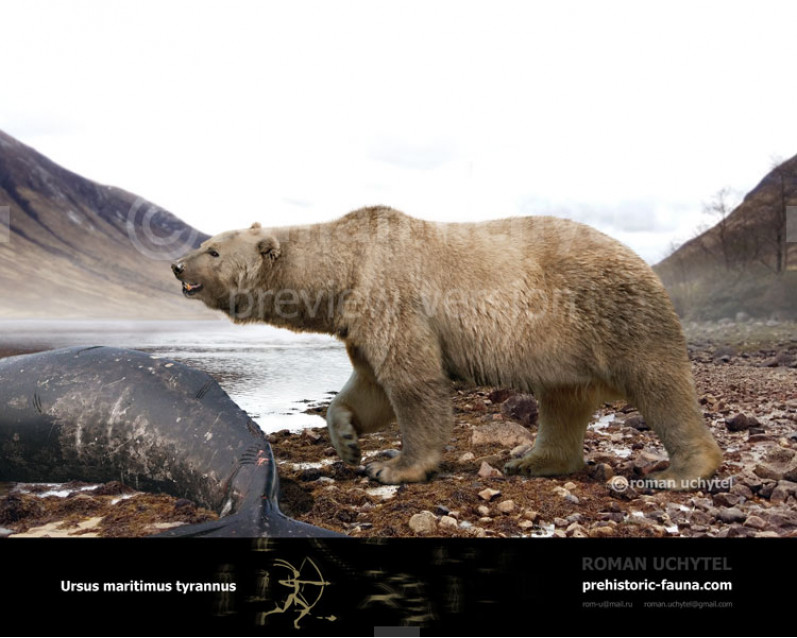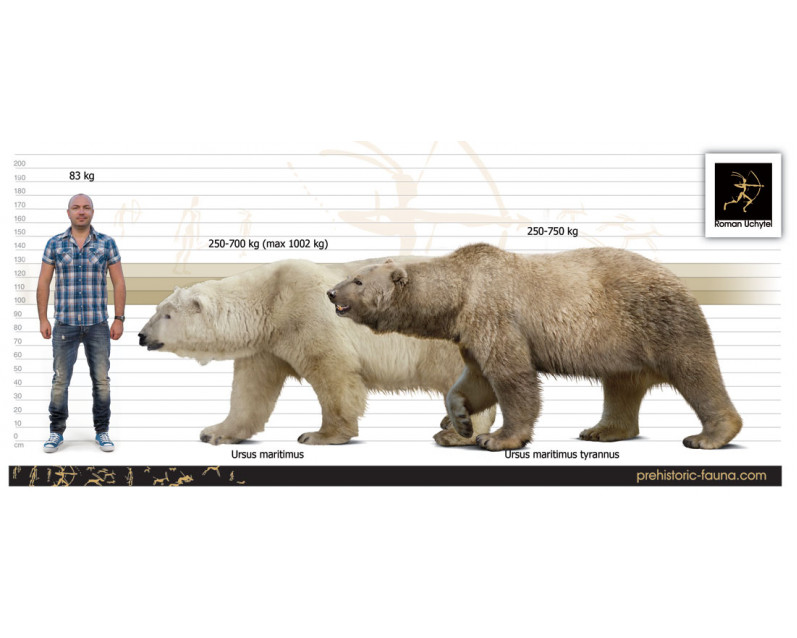Ursus maritimus tyrannus (Tyrant polar bear)
297297Ursus maritimus tyrannus (Ursus maritimus tyrannus Kurtén, 1964)
?Ursus arctos priscus
Order: Carnivora
Family: Ursidae
Size: 3,5 m in length, 145 cm in height, 350 - 1000 kg of weight
Time period: the Late Pleistocene of Northern Eurasia (70,000 years ago)
Typical representative: Ursus maritimus tyrannus Kurtén, 1964
Ursus maritimus tyrannus is an extinct subspecies of polar bear, known from a single fragmentary ulna found in the gravels of the Thames at Kew Bridge, London. It was named by the Finnish paleontologist Björn Kurtén in 1964 and is interpreted to represent a relatively large subadult individual: the ulna is estimated to have been 48.5 cm long when complete, recent studies only weigh it at 400 kg, for comparison modern subadult polar bear ulnae are 36–43 cm long. Dating back to the Late Pleistocene, approximately 70,000 years ago, it is the oldest fossil assigned to the polar bear; however, an unpublished reinvestigation of the fossil suggests that the fossil is actually a brown bear.
Commonly used names include: Pleistocene polar bear or Tyrant polar bear.
From Wikipedia, the free encyclopedia
Ursus maritimus tyrannus (Ursus maritimus tyrannus Kurtén, 1964)
?Ursus arctos priscus
Order: Carnivora
Family: Ursidae
Size: 3,5 m in length, 145 cm in height, 350 - 1000 kg of weight
Time period: the Late Pleistocene of Northern Eurasia (70,000 years ago)
Typical representative: Ursus maritimus tyrannus Kurtén, 1964
Ursus maritimus tyrannus is an extinct subspecies of polar bear, known from a single fragmentary ulna found in the gravels of the Thames at Kew Bridge, London. It was named by the Finnish paleontologist Björn Kurtén in 1964 and is interpreted to represent a relatively large subadult individual: the ulna is estimated to have been 48.5 cm long when complete, recent studies only weigh it at 400 kg, for comparison modern subadult polar bear ulnae are 36–43 cm long. Dating back to the Late Pleistocene, approximately 70,000 years ago, it is the oldest fossil assigned to the polar bear; however, an unpublished reinvestigation of the fossil suggests that the fossil is actually a brown bear.
Commonly used names include: Pleistocene polar bear or Tyrant polar bear.
From Wikipedia, the free encyclopedia


-797x638.jpg)


-70x56.jpg)

-346x277.jpg)

-346x277.jpg)






